First Street Between Lake and Spruce 1930's-1950's
Introduction
Text-to-speech Audio
Ilwaco was a bustling town in the early to mid- twentieth century. Much of the Peninsula shopping and banking was done in Ilwaco. It was the fishing center and as such, employed many people in the canneries as well as in the commercial and sport fishing industry. The fishing industry continues to be a major employer in Ilwaco. There were many different commercial buildings in this area of 1st Street over the years. Businesses included a grocer, pool hall, barber shop, bank, department store and more. Learn about some of their stories below.
Images
Ilwaco, 1st Street looking North.
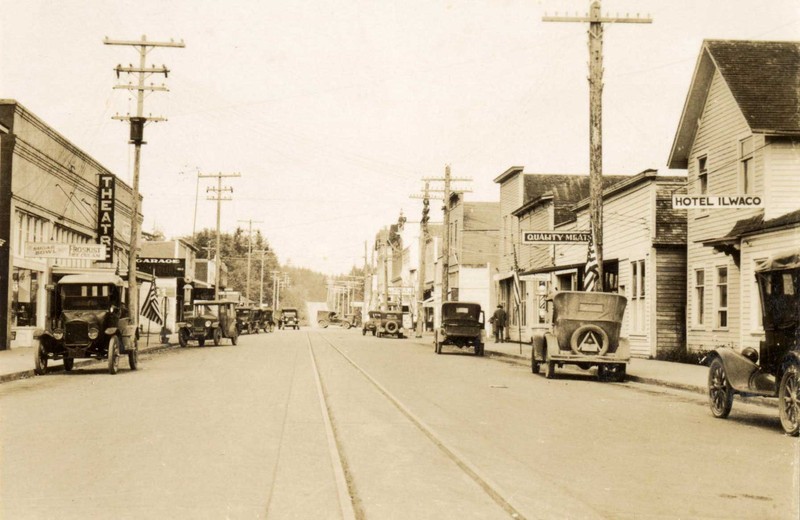
Train heading South on First St, in Ilwaco - Ford photo
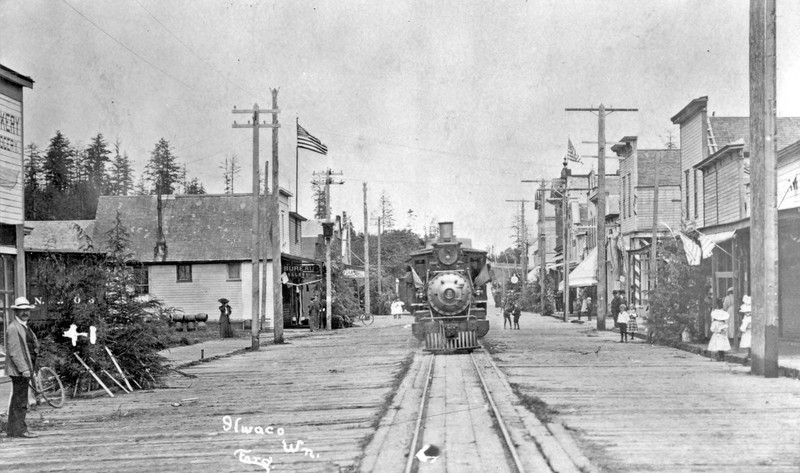
1st St facing North. Postcard.
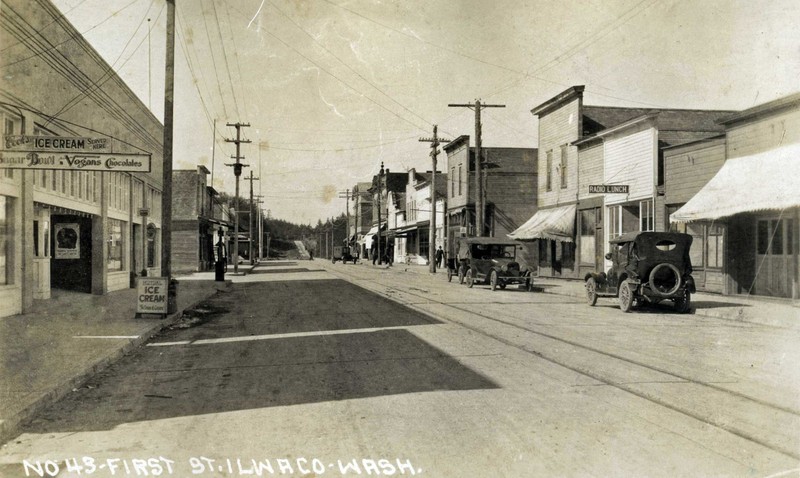
Ilwaco Railroad tracks on 1st between Spruce and Lake Streets.

Brumbach Barbershop, Ilwaco, WA
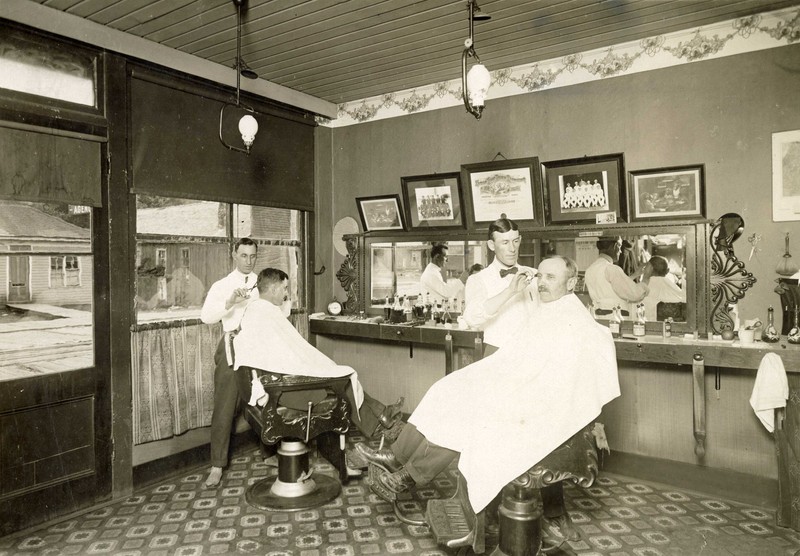
Heckman and Nott Store, Interior, Ilwaco 1935. Fitzpatrick photo.
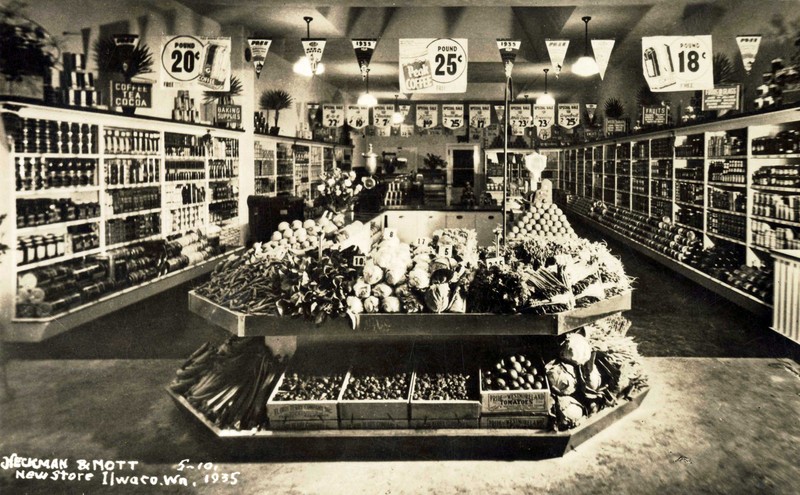
First National Bank, located in Ilwaco at 1st and Spruce.
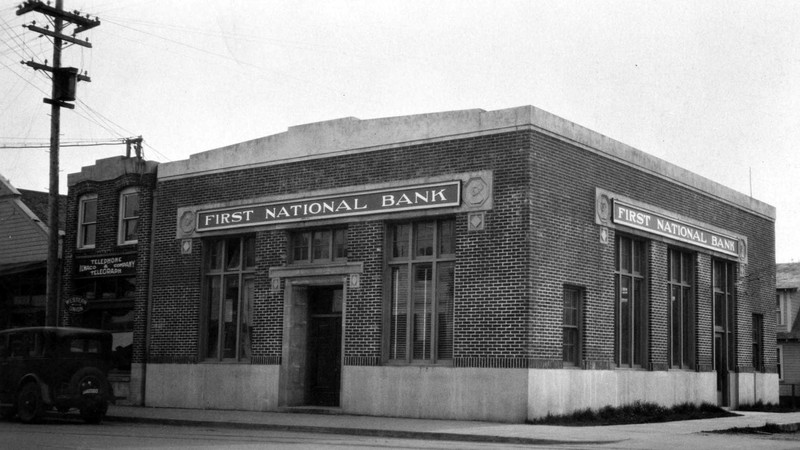
Jack Williams and Jr. in front of the Ilwaco Theater. C. 1934. Fitzpatrick photo.
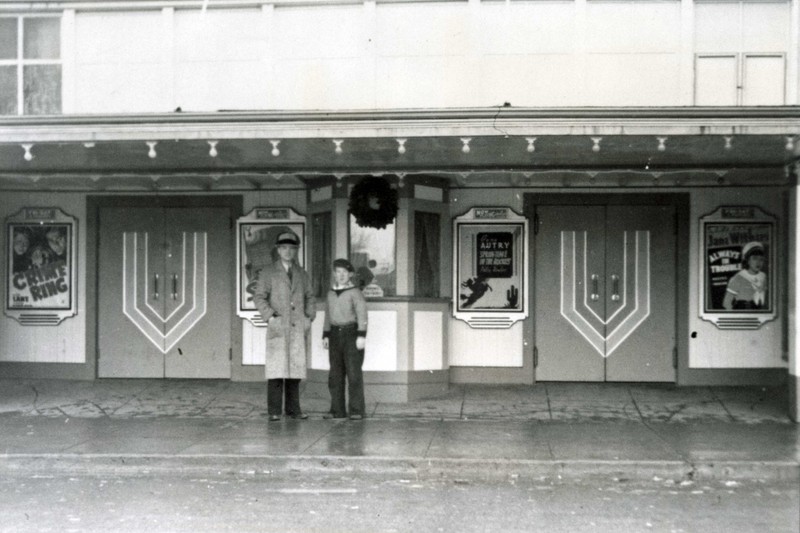
Backstory and Context
Text-to-speech Audio
The Rise of Recreational Fishing
Though angling developed centuries ago, the rise of recreational fishing as a popular pursuit took on a new dimension in the years after World War II. Towns such as Ilwaco, Chinook, Astoria, and Warrenton began to see new potential in recreational salmon fishing as an opportunity for business development. Salmon derbies were begun as a way to exploit this rising interest. In the early years, commercial fishermen took sport-fishing customers out in their boats. Eventually knowledgeable fishermen took advantage of this expanding opportunity by offering charter services. Thus emerged the charter-boat fishing industry, which has been a mainstay of the business landscape of Ilwaco for decades.
In the 1950s and early 1960s, the salmon derby in Ilwaco was “big doings. The town and the marina were "plug-loaded" with tourists here for the derby. That became the push to redevelop the marina at the Port of Ilwaco in the late 1950s. Up until that point, the harbor had largely been devoted to commercial fishing vessels. Mayor Norman Howerton's grand plan to enlarge the marina capacity allowed more space in the harbor devoted to recreational fishing craft rather than to commercial fishing vessels. The development was a boon to those businesses catering to sport fishermen, but proved a detriment to some of those serving the commercial fleet.
Good times don’t last forever. In the 1970s, salmon fishing became increasingly restricted, and the derby lost much of its luster. The marina began to look increasingly empty. It would take a number of years to develop an interest in recreational fishing for other species, such as sturgeon, halibut and bottom-fish. By the 1990s, some local charter operators were telling their customers, salmon fishing's over, but we’ve got great sturgeon and halibut fishing. By then, improved ocean conditions, following the flood years of 1996 and 1998, brought back the large salmon runs to the Columbia River. Run-sizes between 2002 and 2004, were among the highest seen since record-keeping began at Bonneville dam in 1938. Once again, the marina was packed. The derby was back! New restrictions have since been put into place on coho and fall Chinook. What will the future bring?
William Brumbach - Barber
William Cullen Brumbach was born in 1877 in Butler, Missouri, and came to Ilwaco with his parents when he was 10. His father, Jeremiah, was a pioneer judge and city official. After graduating from Ilwaco, he went to Whitworth College, where he finished a business course.
He worked on the Sand Island seining grounds for several years and then took off for Alaska during the gold rush. On his return, he joined the Coast Guard at Cape Disappointment and was on the lifeboat drill team that performed daily at the Alaska-Yukon Exposition in Seattle. While at the Cape, he met his wife, who was living at Fort Canby with her family. They were married in 1905.
He opened up his barbershop, one door north of the corner of First and Lake in Ilwaco in 1910, and continued in the same location until his retirement in 1960. At that time, it was the oldest continuous business enterprise in Ilwaco.
He put in 30 years of service to his adopted town, seven terms as Mayor, and 18 years as Town Clerk. He passed away in 1965 and is buried in the Ilwaco Cemetery.
W. B. Hawkins - Meat Market and Wagon
William Borthwick Hawkins was born in New Zealand in 1864 and came to Ilwaco with his parents in 1870. One of eleven children, he worked as a fisherman in Astoria, and later went into business with his brothers operating a very successful transfer station in Ilwaco. However, Hawkins was perhaps best known for his meat market and delivery service. The Sandborn Map indicates that the market was located on First St., right in the middle of Lake and Main, on the east side. We know that by 1891, a visitor’s brochure states, “he has a first-class meat market, and does a large business.” His advertising states that he was a wholesale and retail dealer in all kinds of meats; poultry, fish, clams, and all types of game. During the summer season, he would take orders along the beach and deliver to seaside visitors and cottages.
One of his brothers, Benjamin, went on to open a meat market in Vancouver, while another, Edgar, continued with the transfer station, ran a taxi service, and a contracting business here in Ilwaco. Later he sold the transfer station to Allan Goulter.
William Hawkins was a resident of Ilwaco for 60 years before going to live with his daughter during the last decade of his life. At the time, he was one of the oldest members of the Occident Lodge No. 99 (Masons), holding an honorary membership at the time of his death in 1944. He was buried in the Mountain View Cemetery in Ashland, OR., alongside his wife Alice Luzana (Zanie) née Hall of Chinook. She ran the Chinook Hotel for a time, and later a restaurant in the Baseel Building.
James L. Nott – Jim’s Grocery
James Nott, a lifetime resident of Ilwaco was born in 1897, his father Harvey was a pioneer barber in town. While still in high-school, Jim started working at Kerlee’s Aberdeen Store as a delivery boy and then a clerk. After taking a course at the Astoria Business College, he became the bookkeeper.
After serving in the army during WWI, he returned to Ilwaco and worked for Max Wise’s grocery store (located on the west side of First St. and north of Lake) where a year later he met James Heckman who had just started working there. The two men formed a partnership in 1919 and bought out Mr. Wise.
In 1923, Jim Nott married Helen Hansen of Chinook, they had one daughter, Janet (Morrison).
In 1935, the two James’ (Heckman and Nott) bought the lot across the street from their store, tore down the old three-story building, and replaced it with a modern concrete building. This is where Azure is located today. After Mr. Heckman passed away in 1952, Mr. Nott continued to run the business on his own.
Jim’s Cash Grocery served Ilwaco for 50 years.
Jim Nott also served Ilwaco for many years as a city councilman. He was mayor for one term and was acting mayor on two other occasions. He was also on the fire department during WWII when the fire station was manned day and night. He was also a charter member of the American Legion and the Kiwanis Club and was active in other fraternal organizations. He died in 1970 and is buried in the Ilwaco Cemetery.
Movie Theaters on the Peninsula
“Ed Saunders has the first moving picture show in Ilwaco, which he called the Bell Theatre. It was situated about where (Olde Town Coffee Shop on 1st and Spruce) is today. It was established about 1914…. At the same time the (Walter) Strauhals operated a picture show in a tent in Long Beach (about where the Long Beach Pharmacy is today.) during the summer months and Jack O’Bryan showed films in Seaview… In 1923 Doupe and Rogers put up a regular theater building with a sloping floor and stage. The Sea Hag Tavern occupie(d) this space and it was later owned by Charles Strauhal. In 1926 my brother-in-law Curtis Hoare and I purchased both the Ilwaco and Long Beach Theaters.
We ran one show per night, 35 cents for adults, 10 cents for children were the going rates in nearly all small towns. When a “Gone with the Winds,” or some other big production came along we upped the tariff to 50 cents….The theater was sort of a glamorous place to work and help was always plentiful if not overpaid. The projectionist was the top employee receiving $2 per night for around 2 ½ hours of work. I only paid the cashier 50 cents a night at first….
The ushers were high school girls who worked for nothing just to see the show. For music, the Long Beach theater had player piano with Bessie Whitten at the keyboard… the Ilwaco theater has more class where a mechanical pipe organ coasting some $5000 was operated by Oscar Koski. It had many sound attachments which Oscar used with good effect to embellish the action on the screen.
For heat we used wood stoves made out of empty gasoline drums made by Oscar Nyberg. The drums would take cord wood stick…I would go down during the show, open the stove door and fire up. Couldn’t help but get a lot of light and some smoke into the auditorium but no one seemed to mind. During the winter months, before Long Beach had any drainage, water would often come into the theater about up to the first three or four rows of seats and maybe four to five inches deep. During those periods I always kept a pair of boots near the first dry row and would slip them on before wading to the big stove to put in more wood. The fire light on the water when the stove door opened produced a nice effect not many theaters could boast of.”
Sources
Source: CPHM Research Files
CPHM Photo Collection: Tribune, August-25-1967-Ilwaco-Salmon-Derby-Women's-winner, -Betty-Wilson-38lbs-9oz
Descriptive & Illustrated Review of the Ocean Beach; The Chinook Observer; Sanborn Map of Ilwaco 1909.
The Tribune – April 15, 1960, July 1, 1960; The Longview Daily News – May 13, 1965.
The Tribune – April 22, 1960; Longview Daily News – January 15, 1970.
Joan Mann interview of John “Jack” Grouille Williams
2017.050.019
2014.052.020
CPHM Photo Archive - L1983.45.10
CPHM Photo Archive - No-ACCT#-3503-9-B
2015.042.004
CPHM Photo Archive - 1984.266.030
1987.110.300
CPHM Photo Archive - 2014.052.002
